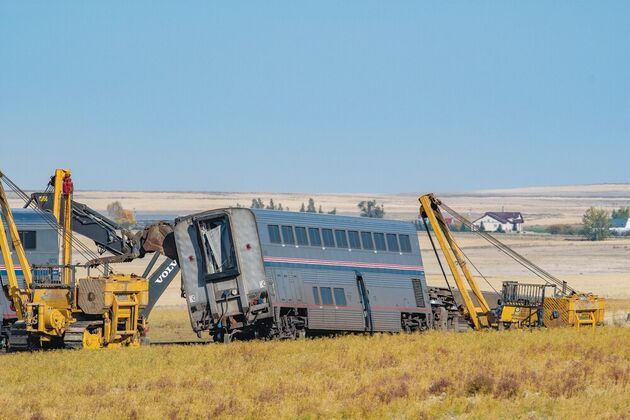The National Transportation Safety Board announced Thursday that “poor track conditions” led to an Amtrak derailment near Joplin in September 2021, killing three and injuring scores more.
On Sept. 25, 2021, Amtrak’s westbound Empire Builder, which connects Chicago with Portland and Seattle, derailed on a curve near Joplin while traveling 77 miles per hour, two miles per hour below the posted speed limit for that section of track. The train was operated on track owned by BNSF Railway.
According to the NTSB report, 11 other trains, including 10 BNSF freight trains and one Amtrak passenger train, had traveled over that stretch of track the same day. Most trains have outward-facing cameras onboard, and footage from the three previous trains showed that the track was slowly being knocked out of alignment throughout the course of the day. By the time the westbound Amtrak train arrived at approximately 4 p.m., the rails had moved about 2.9 inches.
But investigators found that was not the only issue with the track at that location. The rail on that section of track was also worn down, meaning the inside flange of the wheels was more likely to hit the joint bar, a metal bar that connects two sections of rail. Finally, the track subgrade, essentially the rock and soil foundation the tracks are built on, was unstable. While some vertical movement of the track is normal when a train passes over, NTSB investigators observed that the track was moving more than it should even after the rail line had been repaired and reopened after the derailment.
RELATED
Feds launch multiple probes into deadly Amtrak wreck
Investigators with the National Transportation Safety Board and Federal Railroad Administration have descended on a remote stretch of railroad track east of Havre this week trying to figure out why Amtrak’s Empire Builder passenger train derailed Saturday, killing three and injuring scores more.
Ultimately, the NTSB found that no single issue caused the derailment, but rather a combination of factors. In fact, none of the individual defects violated safety measures set by the Federal Railroad Administration. Investigators wrote that there is a “long history” of derailments caused by a combination of factors, and encouraged the federal government to come up with new standards to prevent such derailments in the future.
Given how rapidly the track conditions deteriorated on the day of the derailment, investigators said it was unlikely the regular regimen of track inspections would have caught the defects that led to the accident. BNSF regularly inspects the tracks twice a week, as required by law, and had inspected the specific stretch of track just two days before the derailment. However, investigators said that if all the trains that passed through the area been outfitted with autonomous track monitoring systems, the deteriorating track conditions might have been noticed and the railroad notified of a problem. That type of monitoring equipment is not required by law, but the NTSB has encouraged its use in the past and the board once again reiterated the recommendation at the end of its accident report.
Besides the autonomous inspection equipment, the NTSB recommended that the federal government come up with new standards, specifically in regards to how worn a piece of rail can be before it must be replaced. It also recommended that BNSF do more to stabilize the subgrade beneath the track at Joplin.
“This tragedy is a powerful reminder that there’s no substitute for robust track inspection practices, which can prevent derailments by identifying track conditions that may deteriorate over time,” NTSB Chair Jennifer Homendy said in a press release. “I implore track owners, who are responsible for the safety of their routes, to ensure inspectors have the time, support, and resources needed to do their work, which is essential to rail safety.”
In a statement to the Montana Free Press, BNSF said it is still reviewing the NTSB report and is already making improvements to its infrastructure, including beginning to install autonomous track inspection equipment on locomotives.
“While we haven’t had a chance to fully review the findings yet, we are committed to safety across our system,” spokesperson Lena Kent wrote.
Amtrak officials said they also were reviewing the report on Thursday.
“Amtrak appreciates the opportunity to participate in the investigation and we will review the recommendations. Amtrak will continue to work with all stakeholders to improve rail safety for the traveling public,” spokesperson Marc Magliari wrote.
The NTSB’s final report comes as the nation’s rail system has faced increased scrutiny in recent months following a series of high-profile derailments, including in Montana. In April, a BNSF train operated by Montana Rail Link derailed near Quinn’s Hot Springs, spilling cases of beer into the Clark Fork. In June, another train on MRL derailed when a bridge collapsed over the Yellowstone River near Reed Point, spilling asphalt into the water. And in the last week, two different trains derailed on BNSF Railway tracks near Havre, about 50 miles east of the site of the 2021 wreck.
According to the Federal Railroad Administration, more than 1,000 trains derail every year in the United States.
LATEST STORIES
Youth climate ruling looms large in Montana Supreme Court hearing about Laurel gas plant
Environmental groups challenging a gas plant under construction near Laurel asked the Montana Supreme Court to uphold a lower court’s decision to block the project.
Helena school district cuts more than 50 non-tenured teachers due to budget strains
The Helena School Board of Trustees voted unanimously not to renew the contracts of 52 non-tenured teachers.
Missoula taxpayers asked to fund additional resources for fire department
The levy would pay for 20 new firefighters, a sixth station, equipment and the mobile support team, which responds to behavioral-health-related calls. At current rates, the levy would raise $7 million in the first year, with the owner of a $300,000 home paying $138 and the owner of a $600,000 home paying $276.


